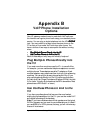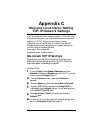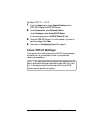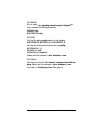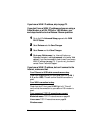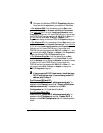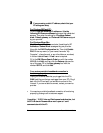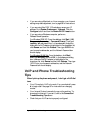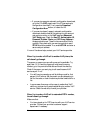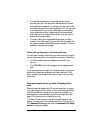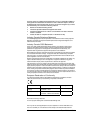
Appendix D: Troubleshooting 73
1
11
1 First open the Windows
TCP/IP Properties
dialog box.
How you do this depends on your version of Windows:
—For Windows 2000:
From the desktop click the
Start
button,
point to
Settings
and then
Network and Dial-up Connections
.
Then right-click (NOT left-click)
Local Area Connection
,
select
Properties
, highlight your NIC card’s
TCP/IP
entry (it should start
with
TCP/IP
and have the characters
10/100
,
NIC
, or
Ether
in it –
and not have the words
AOL
,
Dial-up
, or
Adapter
). Click
Properties
to display the Windows
TCP/IP Properties
dialog box.
—For Windows XP:
From the desktop click the
Start
button, point
to
Control Panel
and then
Network Connections
. Then right-click
(NOT left-click)
Local Area Connection
,
select
Properties
,
highlight your NIC card’s
TCP/IP
entry (it should start with
TCP/IP
and have the characters
10/100
,
NIC
, or
Ether
in it – and
not have the words
AOL
,
Dial-up
, or
Adapter
). Click
Properties
to
display the Windows
TCP/IP Properties
dialog box.
—For Windows 98 and Me:
From the desktop click the
Start
button, then point to
Settings
and then
Control Panel.
Double-
click the
Network
icon to display the
Network
configuration screen.
Double-click NIC card’s
TCP/IP
entry (it should start with
TCP/IP
and have the characters
10/100
,
NIC
, or
Ether
in it – and
not have the words
AOL
,
Dial-up
, or
Adapter
) to display the
TCP/IP Properties
dialog box.
2
22
2
If you are using DHCP (most users), check that your
DHCP settings are okay. If you are using a static IP
address, skip to Step 3.
For Windows 2000 and XP:
Make sure that
“Obtain an IP address automatically”
is
selected on the
General
tab and that
“Obtain a DNS server
address automatically”
is selected on the
DNS
Configuration
tab. All fields should be blank.
For Windows 98 and Me:
Make sure that
“Obtain an IP address automatically”
is
selected at the
IP Address
tab and that “
Enable DNS
” is
selected on the
DNS Configuration
tab. All fields should be
blank.





